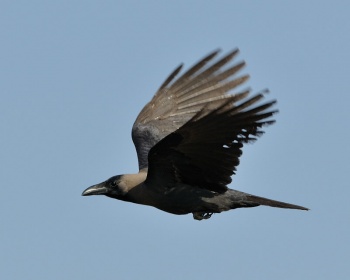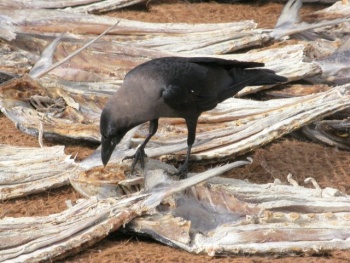(added more pictures) |
m |
||
| Line 19: | Line 19: | ||
Polytypic: | Polytypic: | ||
* ''C. s. zugmayeri'' found from southeast [[Iran]] to [[Pakistan]], northwest and northcentral [[India]] | * ''C. s. zugmayeri'' found from southeast [[Iran]] to [[Pakistan]], northwest and northcentral [[India]] | ||
| − | * ''C. s. splendens'' in most of the [[India]]n Peninsula, [[Nepal]], [[Bhutan]] and '' | + | * ''C. s. splendens'' in most of the [[India]]n Peninsula, [[Nepal]], [[Bhutan]] and [[Bangladesh]], ship-assisted immigrant to western [[Australia]] |
| − | * ''C. s. protegatus'' in southwest [[India]] | + | * ''C. s. maldevicus'' in the [[Maldives]] |
| + | * ''C. s. protegatus'' in southwest [[India]] and [[Sri Lanka]] | ||
* ''C. s. insolens'' in extreme south [[China]] ([[Tibet]] and Yunnan) and [[Burma]] | * ''C. s. insolens'' in extreme south [[China]] ([[Tibet]] and Yunnan) and [[Burma]] | ||
Introduced populations in many cities and harbours around the Indian Ocean and beyond. Occurs in the Western Palearctic in [[Egypt]] and [[Israel]]. Sometimes in [[Europe]]an ports like Rotterdam. | Introduced populations in many cities and harbours around the Indian Ocean and beyond. Occurs in the Western Palearctic in [[Egypt]] and [[Israel]]. Sometimes in [[Europe]]an ports like Rotterdam. | ||
| Line 33: | Line 34: | ||
A resident species with some short-distance movements. | A resident species with some short-distance movements. | ||
==References== | ==References== | ||
| − | #{{Ref- | + | #{{Ref-Clements6thAug15}}#{{Ref-HBWVol14}} |
{{Ref}} | {{Ref}} | ||
==External Links== | ==External Links== | ||
{{GSearch|Corvus+splendens}} | {{GSearch|Corvus+splendens}} | ||
[[Category:Birds]][[Category:Corvus]] | [[Category:Birds]][[Category:Corvus]] | ||
Revision as of 10:23, 12 September 2015
Alternative names: Indian Crow; Indian House Crow; Grey-necked Crow; Colombo Crow
- Corvus splendens
Identification
40 - 43cm. A small and slim-bodied crow.
- Prominent, long black bill, slightly arched and enhanced by short forecrown
- Plumage blackish-slate, blacker and glosser on face, forecrown, chin and throat
- Mantle, side of neck and side of breast medium-grey, shading into blackish-grey on back and belly. Much paler grey in zugmayeri, with almost no contrast to black in insolens
- Dark brown iris
- Black legs
Sexes similar. Juveniles are duller than adults.
Similar species
The subspecies insolens may be confused with Large-billed Crow. Note the shape of the head and the size.
Distribution
Pakistan, Sri Lanka, Maldives and India, Burma, Bhutan, Nepal and coastal southern Iran. Spreads to Eastern Africa (as blind passengers on ships) and the Middle East.
Abundant in most of its range.
Taxonomy
Polytypic:
- C. s. zugmayeri found from southeast Iran to Pakistan, northwest and northcentral India
- C. s. splendens in most of the Indian Peninsula, Nepal, Bhutan and Bangladesh, ship-assisted immigrant to western Australia
- C. s. maldevicus in the Maldives
- C. s. protegatus in southwest India and Sri Lanka
- C. s. insolens in extreme south China (Tibet and Yunnan) and Burma
Introduced populations in many cities and harbours around the Indian Ocean and beyond. Occurs in the Western Palearctic in Egypt and Israel. Sometimes in European ports like Rotterdam.
Habitat
In a variety of tropical and subtropical habitats, usually near cities, towns or villages.
Behaviour
Diet includes human scraps, small reptiles and other animals such as insects and other small invertebrates, eggs, nestlings, grain and fruits.
Does great damage to crops and known to kill newborn domestic animals.
Usually seen in groups, sometimes big flocks. Has little fear of man but is always alert and constantly wary.
Breeding season varies in its range. It lays 3-6 eggs in a typical stick nest, and occasionally there are several nests in the same tree. In South Asia they are parasitized by the Asian Koel.
A resident species with some short-distance movements.
References
- Clements, J. F., T. S. Schulenberg, M. J. Iliff, D. Roberson, T. A. Fredericks, B. L. Sullivan, and C. L. Wood. 2015. The eBird/Clements checklist of birds of the world: v2015, with updates to August 2015. Downloaded from http://www.birds.cornell.edu/clementschecklist/download/
- Del Hoyo, J, A Elliott, and D Christie, eds. 2009. Handbook of the Birds of the World. Volume 14: Bush-shrikes to Old World Sparrows. Barcelona: Lynx Edicions. ISBN 978-8496553507
Recommended Citation
- BirdForum Opus contributors. (2024) House Crow. In: BirdForum, the forum for wild birds and birding. Retrieved 8 June 2024 from https://www.birdforum.net/opus/House_Crow






